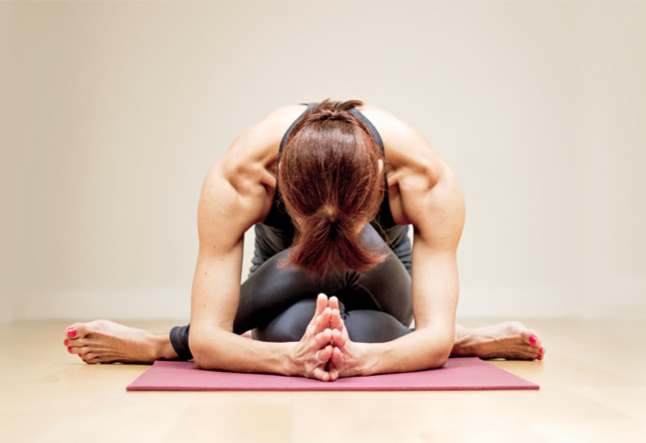yin yoga

a deeper practice
Taoism describes an essential equilibrium – yin and yang – as manifest in everything. Yin, characterized as being solid, static, dim, and concealed contrasts with the fluid, kinetic, bright, and apparent qualities of yang. Despite obvious distinctions these concepts are subject to context – one yogi’s yin is another’s yang, sort of.
Exercise is typically yang in nature – rhythmic and repetitive – alternately contracting and relaxing muscles. Modern yoga classes tend to be athletic, although they are often depicted as more serene and static than swimming, cycling, running or weight lifting. Some classes, such as Ashtanga or Power Yoga, flow with such vigor, pose to pose, that they venture well into the yang end of the activity continuum. Hardly relaxing or soothing, yoga is a workout. Indeed, Yang yoga stretches and strengthens muscle, and conforms neatly to our puritanical exercise ethic that says “if you’re not sweating, you’re slacking.” Yin yoga, conversely, offers a complementary balance to bodies relentlessly tasked with yang endeavors, but stresses them nonetheless.
The nature of physical stress changes as it slides across its continuum. The same pose, when directed at muscle, produces far different effects when directed at joints. Consider reframing a workout as simply stimulation, instead of the expected rhythmic, repetitive loading of the neuro-muscular, musculo-skeletal and cardio-respiratory systems. Obviously, exercise can be physical exertion, which fires the systems above, but stimulation occurs in more subtle ways too. Yin yoga stimulates connective tissue surrounding the athletic joints of the hips, pelvis, and spine with protracted, passive leverage. Plus, it circulates chi (life force) through said tissue, but that’s another story (see sidebar).
Connective tissue serves a protective purpose, resisting sharp forces seeking to separate joints. In the course of normal activity it deforms only slightly then returns, instantly regaining its shape, ideally preventing injury. It holds you together.
The accepted paradigm of connective tissue is that it’s not particularly dynamic in the way muscle is. It doesn’t contract and relax actively. But connective tissue – ligaments and the sheathing around joints – does contract aggressively when immobilized. Daily sitting, especially, robs us of natural ease of reach, as does our typical repertoire of narrow-range activities, such as jogging. Contracture, as it’s known, occurs in vital areas – the hip joints, the SI (sacro-iliac) joints, and about the lumbar vertebrae – impinging normal function. Arguably, back pain ensues, plaguing about 85% of our population, but is absent from primitive cultures where prolonged squatting, versus sitting, is the norm.
Yin yoga progenitor Paul Grilley points out that athletes don’t retire due to failing muscles, but failing joints – another example of use it or lose it. The solution is to rejuvenate these articulations. And, while yoga generally improves flexibility, Yin yoga is WD-40 for seized or rusting joints. While shorter duration, repetitive (yang) movement is the correct stressor for addressing muscle tissue, it is inappropriate for exercising joints in much the same way that it would be for exercising teeth. Orthodonture succeeds because its prolonged, low-grade tension effects favorable change. Connective tissue around joints, roughly analogous to teeth, also responds to a gentle, steady pull, over time. Grilley states simply, “The fundamental characteristic of Yin yoga is holding poses for several minutes. And, to successfully stress the connective tissue about a joint, surrounding muscles must be relaxed.”
Continuing its elegant simplicity, only a few types of poses are essential to Yin yoga – forward bends, back bends and spinal twists, all mostly floor borne – and they’re quite familiar. The vast repertoire of yogic postures accommodates all iterations of skeletal configurations, offering variety for individual abilities and interests. And, this is especially important: the efficacy of Yin yoga is decidedly not dependent on dogmatic adherence to abstract alignment. Indeed, this discipline views unique skeletal structure, not idealized poses, as legitimate endpoints in asana perfection, affording a universally accessible practice, and a lot less novice frustration.
“The line or aesthetic of a pose is not a functional justification of its correctness or un-correctness,” says Grilley. In any event, props – blocks, bolsters and blankets – can ensure relative comfort, making prolonged postures possible or providing additional leverage when needed.
So, let’s sum up. Yin yoga coaxes the more plastic connective tissue into returning to normal, functional length, thus remaining healthy, through the gentle stress at the joints of the lower back and hips with a relatively small number of postures held over a protracted period. Yang yoga targets elastic muscle tissue with rhythm and repetition, improving tone, stamina and suppleness. As yin is only appreciated in respect to yang, look at Yin yoga as supplementing your Yang practice, not replacing it.
